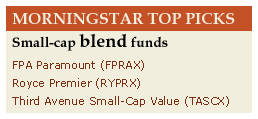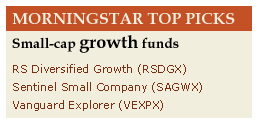NEW YORK (CNN/Money) – If dictionaries were rewritten every year, the latest definition of the word "boffo" might be "small-cap stock performance, circa 2003."
Last year, the most widely known index of small-caps -- the Russell 2000 -- rose 47.3 percent, well above the large-cap S&P 500 index, which rose 26.4 percent. Over the past 1-year period through Feb. 27, the Russell is up 64.4 percent.
And the results are even more impressive if you measure the bottom 20 percent of the U.S. equity market, which includes micro-caps that are too small to be included in the Russell 2000. That segment rose 60.7 percent in 2003, according to Ibbotson Associates.

Can small caps keep running? The consensus seems to be that while there may still be some upside, there's no denying that the group has gotten pricier.
One fund manager who sees both sides of the debate is John Montgomery, president of Bridgeway Funds. His Bridgeway Ultra-Small Company Fund (BRUSX), which is passively managed using quantitative models, rose a whopping 88 percent in 2003, making it the No. 1 fund in its category. (Don't rush to call your broker, though. The fund is closed to new investment.)
The arguments in favor of a continued bull run, he said, are momentum -- primarily, money chasing performance -- and that small caps tend to do well early in an economic recovery, a stage that Montgomery believes the U.S. is still experiencing.
But he now thinks small caps are close to being fully valued. And of his fund's blockbuster return in 2003, he said, "I promise you that will not continue unabated."
While it wouldn't surprise him if 2004 turns out to be another good year for small caps, he's placing his personal bets on an eventual cool-down, having recently reduced his small-cap exposure in his own retirement account. He cut his small-cap allocation to 42 percent from 68 percent.
Acknowledging that his current allocation is still quite high, Montgomery said, "I have a steel stomach."
I want to get me some of that ...
Of course, if you don't happen to run a top small-cap fund in the country, putting 42 percent of your money in small caps can be a highly risky move.
Despite the impressive long-term performance of small caps -- average returns of 12.7 percent since 1926, versus 10.4 percent for large caps -- Ibbotson recommends the most aggressive investors have no more than 15 percent of their total portfolio in small-cap stocks; moderate investors no more than 10 percent and conservative investors no more than 5 percent.

Why not more? Because small caps are a volatile asset class. For starters, "their businesses are not diversified like a big company, such as GE," said Peng Chen, Ibbotson's research director. So if anything goes wrong, there aren't other lines of business that can bolster the bottom line.
Plus, Chen said, small companies have a harder time getting credit than larger companies.
Share price also can be volatile because there isn't a great deal of liquidity – or shares outstanding. Consequently, a few large transactions can move a company's stock price disproportionately.
Lastly, small caps have had their share of steep declines. In 2002, for instance, small-cap growth funds sank nearly 28 percent after two consecutive years of more modest losses. And even when they perform reasonably well, they don't always beat out large caps. In the 1990s, small-cap value funds were the worst performing of the U.S. diversified equity fund groups, with an average annual return of 11.6 percent, according to Morningstar. Large-cap growth funds, meanwhile, rose 18.4 percent a year.
Getting the best exposure
Typically, a mutual fund is the best way to get access to the small-cap universe.

Actively managed funds tend to be better bets than index funds since many small-cap stocks aren't widely analyzed. "The price of the security doesn't usually reflect all the information out there, leaving more room for an active manager to exploit those inefficiencies," said Morningstar fund analyst Jeff Ptak.
When picking a small-cap fund, you'll have to choose a growth fund, a value fund or a blend fund, which has both growth and value stocks.
If you can't afford two small-cap funds because investment minimums or expenses are too high, a blend fund should work.
In either case, lower your overall risk by picking a fund that runs in a different direction than your large-cap holding, said Morningstar's William Rocco, also a fund analyst.
For instance, he explained, if the biggest part of your portfolio is in large-cap growth, opt for a small-cap value fund or a blend fund with a value bent.
Or if your large-cap funds tend to invest heavily in health and financials, opt for a small cap offering with heavier exposure in, say, technology. "Pay attention to your overall sector balance," Rocco said.
For a look at some of Morningstar's top picks among small-cap funds, see the graphics in this article. (There are other excellent funds as well, but many are closed to new investors).
And be sure to check out the Money 100 list, which offers more than 20 small-cap funds that were chosen by MONEY Magazine's editors with an eye toward solid long-term performance, strong management, moderate cost and a manageable asset base.

|

